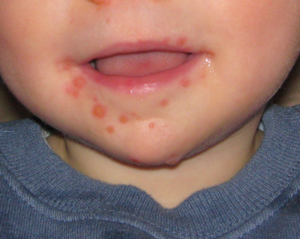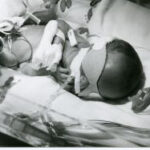Most new parents are worried about protecting their newborn babies from every possible chance of illness and injury. The efforts of keeping chemicals and small parts out of reach protect from poisoning and chocking. Parents keep newborns away from sick individuals as best they can control. Baby wipes and more recently, hand sanitizer are used to sterilize everything. There are some diseases, like hand, foot and mouth disease, which are unable to completely prevent against.
HFMD is a common illness that infants and children contract. Those not parents and not in the practice of caring for infants and young children may not know what HFMD is at all. Hand, foot and mouth disease causes fevers and blister-like rashes in the mouth and on the skin. Some confuse hand, foot and mouth disease with the animal affliction hoof and mouth disease that affect cows, sheep and pigs. The two diseases are not connected and are caused by different viruses. Hoof and mouth disease is not contractible by humans. Hand, foot and mouth disease is not contractible by animals.
Hand, foot and mouth disease shows much like the common cold and flu. It is common for hand, foot and mouth disease to bring about fever, decreased appetite, achiness and sore throats. It is usually after one or two days of fever that the painful sores form in the mouth. The red spots progress to blisters then ulcers on every surface of the mouth’s interior.
The skin rash portion of hand, foot and mouth disease usually develops within one to two days also. This rash is identical to that found in the mouth and progresses in the same degree. The rash can be found on any area of the body’s skin. The usual placement is on the hands and feet giving the disease its name. The rash can also be prevalent on the rear-end and around the genitals.
It is possible for someone with hand, foot and mouth disease to have only the rash in the mouth or only the rash in the mouth.
Much to the dismay of parents and care givers there is no way to prevent hand, foot and mouth disease other than good hygiene and avoiding contact with those suffering hand, foot and mouth disease. The disease spreads by human contact usually by a person with unwashed hands contaminated with the virus. The second most likely place of contact is with surfaces contaminated with the virus. The virus is most contagious in people during the first week of the affliction. It is possible for adults to harbor the virus without suffering symptoms and pass it onto children. Hand, foot and mouth disease cannot be contracted from animals of any kind.
Even more disheartening is the lack of a direct treatment for hand, foot and mouth disease. The symptoms must be treated individually as any other cold or flu symptom is treated. Fever, achiness and pain can be treated by over the counter medications. It is not advised to give children aspirin so it is best to use children’s acetaminophen. There are sprays and mouthwashes that numb oral pain and can be used in this instance. Any use of medication should be delayed until consulting a physician especially in the instances of medicating children.
Luckily, the worst of hand, foot and mouth disease is the discomfort it results in. Use the usual go to remedies used for common cold and flu symptoms and the worst should be over in a few days. Hand, foot and mouth disease is only one of many childhood diseases parents and children must wade through together.







